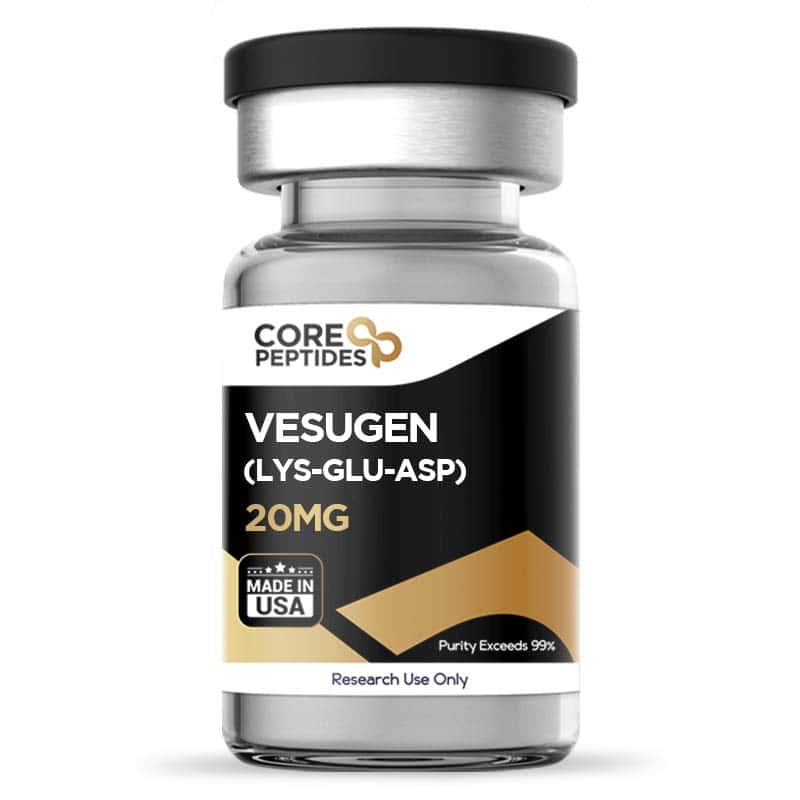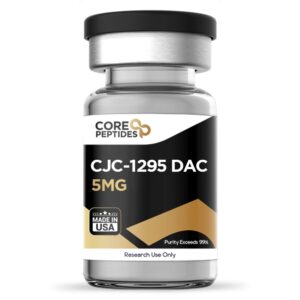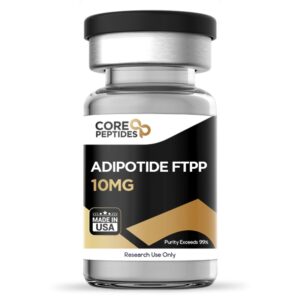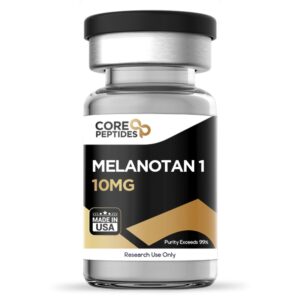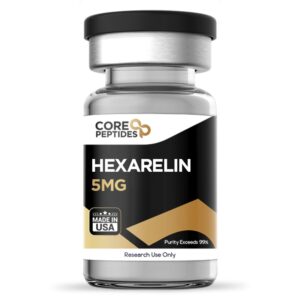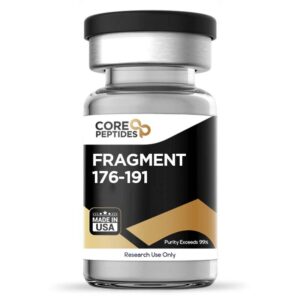Vesugen (20mg)
$59.00
Size: 20mg
Contents: Vesugen
Form: Lyophilized powder
Purity: >99%
SKU: P-VESUGEN-20
FREE Shipping on $200+ orders
FREE Bacteriostatic Water (30ml) on $200+ orders
Discount per Quantity
| Quantity | Discount | Price |
|---|---|---|
| 5 - 8 | 5% | $56.05 |
| 9 + | 10% | $53.10 |
Vesugen Peptide
Vesugen, aka KED, is a bioregulator peptide and identified within the group of peptides isolated and synthesized by Russian scientist, Vladimir Khavinson. It is a tripeptide derived from a sequence of amino acids related to vascular wall proteins, encapsulating the amino acids lysine, glutamic acid, and aspartic acid. Vesugen is primarily known for its potential influence on vascular endothelial cells. Further, its potential extends to a wide array of biological processes, making it a viable research compound within the context of anti-aging and neuroprotection research. Primarily, Vesugen is recognized for its potential vasoprotective impacts, with a particular emphasis on its role in the maintenance and repair of vascular endothelial cells. These cells form the lining of blood vessels. In addition to its vascular implications, Vesugen has also been explored for its neuroprotective and geroprotective consequences. Studies have examined its effects on neuron survival and morphology, suggesting its possible role in combating neurodegenerative diseases and enhancing neuroplasticity.
Chemical Makeup
Molecular formula: C15H26N4O8
Molecular weight: 390.4 g/mol
Sequence: Lys-Glu-Asp
Other known titles: KED, lysyl glutamyl aspartic acid, SCHEMBL3767701
Vesugen Research and Clinical Studies
The information provided below synthesizes the latest insights from early-stage research regarding the capabilities of Vesugen, as demonstrated through a variety of experimental approaches.
Vesugen and Vasoprotective Potential
Vasugen may have vasoprotective potential, particularly relevant in the context of aging and vascular function. This potential is primarily attributed to its proposed ability to influence the behavior of vascular endothelial cells. The available research posits that Vesugen may exert vasoprotective action through the modulation of cell proliferation.(1) It is thought to do this by potentially regulating the expression of the Ki-67 protein, a marker that is closely associated with cellular proliferation. This protein's expression seemingly decreases as part of the natural aging process, affecting the vascular endothelium's ability to renew itself.
Vesugen is hypothesized to interact with the promoter regions of the Ki-67 gene, potentially leading to increased expression of this protein. The possible impact of Vesugen on vascular endothelial cells includes the stimulation of cell proliferation. By potentially enhancing the expression of Ki-67, Vesugen might contribute to the maintenance or restoration of the integrity and function of the vascular endothelium. This may be particularly relevant in addressing age-related vascular function problems, including issues such as reduced proliferative capacity and the increasing prevalence of polyploid cells, which may contribute to vascular lesions and atherosclerosis. Moreover, the study suggests that Vesugen might interact with DNA at specific sites, influencing gene expression in a way that may favor vascular function. This interaction is thought to occur mainly in the minor groove of DNA, with Vesugen forming hydrogen bonds with specific DNA base pairs. Ultimately, the researchers concluded that the “vasoprotective effect of peptide vesugen ... could be realized through epigenetic regulation of Ki-67 gene expression.”
The presumed mechanism underlying its potential effects of Vesugen may involve the epigenetic regulation of genes thought to code for proteins that serve as markers of endothelial functional activity, crucial in cardiovascular function. In vitro investigations into Vesugen's impact on endothelial cells, particularly those impacted by atherosclerosis and restenosis, suggest that it may help normalize the expression of endothelin-1.(2) This molecule's expression typically rises in atherosclerotic and restenotic conditions, suggesting that Vesugen could possibly play a role in addressing these pathologies. Moreover, Vesugen appears to potentially aid in restoring cellular interactions, possibly through its influence on connexin expression. Connexins are vital for cell-to-cell communication, which is essential for maintaining endothelial integrity and function. An additional aspect of Vesugen's potential action is its apparent geroprotective effect, potentially achieved by increasing the expression of sirtuin1, a protein involved in DNA repair. This increase in sirtuin1 expression might be significant for cardiovascular function, as it may contribute to the mitigation of damage at the genetic level.
Vesugen and Neuroprotective Potential
Investigation into Vesugen’s neuroprotective potential within the context of neurodegeneration has elaborated on the apparent impact of the peptide on neuroplasticity and neuron morphology in murine models simulating certain neurodegeneration conditions.(3) A key aspect of this research was the examination of long-term potentiation (LTP) in the hippocampus, a crucial area for memory and learning. The neurodegenerated murine models showed a trend toward impaired neuroplasticity compared to wild-type murine models, particularly after high-frequency stimulation of Schaffer’s collaterals. However, this observed impairment in neuroplasticity was not statistically significant, suggesting only a subtle action.
The exposure to the Vesugen peptide in these murine models suggested a potential to restore LTP, suggesting a role in enhancing neuroplasticity. Despite this positive suggestion, the action of the Vesugen peptide on restoring LTP also did not reach statistical significance, leaving its impact as a promising yet unconfirmed hypothesis. Furthermore, the study delved into the action of Vesugen peptide on neuron morphology, specifically focusing on the dendritic spine density in the CA1 region of the hippocampus. This area is vital for synaptic connections and is notably affected in neurodegeneration. The research found that the introduction of the Vesugen peptide helped prevent the elimination of postsynaptic structures in CA1 neurons of the neurodegeneration murine models. Interestingly, the most pronounced action of Vesugen was observed in the restoration of mushroom and thin spines, which are critical for synaptic strength and memory. This finding aligns with literature data on spine balancing in neurodegeneration progression, suggesting a modulatory action of Vesugen on spine morphology. Moreover, the study noted sex-related differences in the neuroprotective action of Vesugen peptide in neurodegeneration murine models. In male models, Vesugen peptide significantly increased dendritic spine density and restored mushroom spine numbers, suggesting a gender-specific response in neuroprotective action. The authors commented that the neuroprotective potential of Vesugen and similar peptides is “defined by their ability to prevent dendritic spine elimination and neuroplasticity impairments at the molecular epigenetic level.”
Another trial aimed to investigate the mechanisms behind the potential of Vesugen in addressing neurodegenerative conditions.(4) The primary focus was on its influence on gene expression and protein synthesis, which are crucial in processes like apoptosis, aging, neurogenesis, and, more specifically, neurodegeneration. Experimental findings, coupled with published reports, suggest that Vesugen may play a role in regulating the expression of genes associated with cell aging and apoptosis, such as р16 and р21. These genes are pivotal in determining the lifespan of cells and their programmed death, which are critical factors in neurodegenerative diseases. Moreover, Vesugen appears to affect genes and proteins that are involved in neuronal differentiation, such as NES (Nestin) and GAP43. Nestin is a type of intermediate filament protein potentially involved in the structural support of cells, particularly in the early stages of development in the nervous system. GAP43, on the other hand, is a protein that may play a key role in axonal growth during neural development and in the regeneration of neurons. The modulation of these genes and proteins by Vesugen might be integral in fostering neurogenesis, a process that may be beneficial in countering neurodegenerative processes. Furthermore, the peptide seems to interact with genes implicated in the pathogenesis of neurodegeneration. These include SUMO, APOE, and IGF1. SUMOylation, a post-translational modification involving the SUMO protein, is known to be involved in a variety of cellular processes, including transcriptional regulation, DNA repair, and protein stability – all of which are critical in the context of neurodegeneration. APOE, or apolipoprotein E, has been extensively studied for its role in lipid metabolism and its significant association with neurodegenerative diseases. Lastly, IGF1, or Insulin-like Growth Factor 1, is a hormone crucial for brain development and is thought to have neuroprotective properties.
Vesugen and Geroprotective Potential
Vesugen may potentially influence the behavior of prostatic fibroblasts, particularly concerning the expression of certain differentiation factors. This potential was observed in contexts where these cells exhibited signs of aging, suggested by reduced expression of differentiation markers in late-passage cultures.(5) Specifically, Vesugen is posited to stimulate the expression of CXCL12 and WEGC1 in these prostatic fibroblasts. CXCL12, also known as stromal cell-derived factor 1 (SDF-1), is a chemokine, a type of signaling protein. It is primarily indentified for its potential in the immune system, where it may aid in the regulation of immune cell movement. CXCL12 may also be involved in other biological processes, such as hematopoiesis (the formation of blood cellular components) and angiogenesis (the formation of new blood vessels). Its significance in cellular signaling may extend to influencing cell migration and activation, although the full scope of its actions and interactions in various tissues is still a subject of ongoing research. WEGC1, on the other hand, is less extensively studied, and its role is not as clearly defined in the literature. It might be involved in cellular differentiation processes, particularly in specific types of cells like fibroblasts. The exact functions of WEGC1, including how it influences cell behavior and interacts with other cellular components, are areas that require more detailed exploration. Its identification in studies concerning cellular aging and differentiation, such as those involving Vesugen, suggests that it could have a role in these processes, but the extent and nature of this role are yet to be fully elucidated. Most notably, the potential of Vesugen seemed to be more pronounced in aged cultures. This suggests, albeit with a degree of uncertainty, that Vesugen might exhibit geroprotective action, potentially supporting the maintenance or rejuvenation of cellular functions that decline with age.
Clinical research has also aimed to explore Vesugen's potential in modifying biological age markers, a key aspect of aging, and thus its geroprotective potential.(6) Vesugen reportedly exhibited a notable anabolic effect, which is linked to improved activity in the central nervous system and other vital organs. This action was associated with a potential slowing of the aging process according to biological age indicators. An interesting aspect of the study was the observation of prooxidant activity through chemiluminescence. This suggests that Vesugen may induce some oxidative processes. Additionally, there was a reported decrease in CD34+ positive hematopoietic polypotent cells in the blood, suggesting a potential inhibition of hemopoiesis. This finding suggests these cells might not be actively involved in adaptive reactions during the appreciation of Vesugen.
Vesugen peptide is available for research and laboratory purposes only. Please review and adhere to our Terms and Conditions before ordering.
References:
- Khavinson, V. K.h, Tarnovskaia, S. I., Lin'kova, N. S., Guton, E. O., & Elashkina, E. V. (2014). Advances in gerontology = Uspekhi gerontologii, 27(1), 108–114.
- Kozlov KL, Bolotov II, Linkova NS, Drobintseva AO, Khavinson VK, Dyakonov MM, Kozina LS. [Molecular aspects of vasoprotective peptide KED activity during atherosclerosis and restenosis]. Adv Gerontol. 2016;29(4):646-650. Russian. PMID: 28539025.
- Khavinson V, Ilina A, Kraskovskaya N, Linkova N, Kolchina N, Mironova E, Erofeev A, Petukhov M. Neuroprotective Effects of Tripeptides-Epigenetic Regulators in Mouse Model of Alzheimer's Disease. Pharmaceuticals (Basel). 2021 May 27;14(6):515. doi: 10.3390/ph14060515. PMID: 34071923; PMCID: PMC8227791.
- Khavinson VK, Lin'kova NS, Umnov RS. Peptide KED: Molecular-Genetic Aspects of Neurogenesis Regulation in Alzheimer's Disease. Bull Exp Biol Med. 2021 May;171(2):190-193. doi: 10.1007/s10517-021-05192-6. Epub 2021 Jun 26. PMID: 34173097.
- Khavinson VKh, Linkova NS, Polyakova VO, Kheifets OV, Tarnovskaya SI, Kvetnoy IM. Peptides tissue-specifically stimulate cell differentiation during their aging. Bull Exp Biol Med. 2012 May;153(1):148-51. doi: 10.1007/s10517-012-1664-1. PMID: 22808515.
- Meshchaninov VN, Tkachenko EL, Zharkov SV, Gavrilov IV, Katyreva IuE. [EFFECT OF SYNTHETIC PEPTIDES ON AGING OF PATIENTS WITH CHRONIC POLYMORBIDITY AND ORGANIC BRAIN SYNDROME OF THE CENTRAL NERVOUS SYSTEM IN REMISSION]. Adv Gerontol. 2015;28(1):62-7. Russian. PMID: 26390612.

